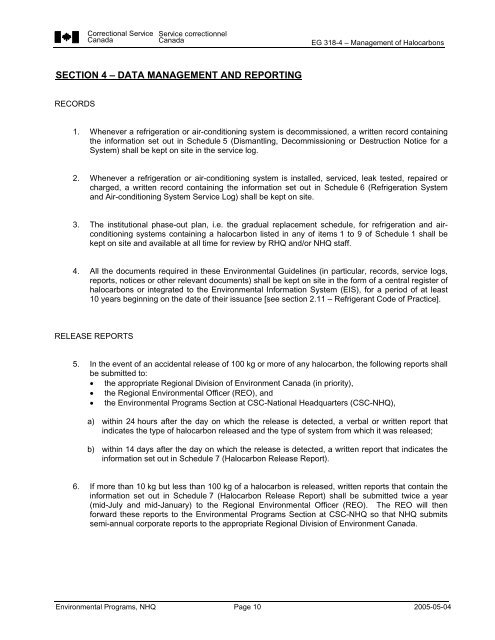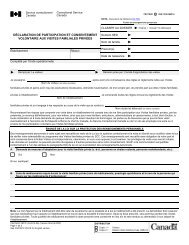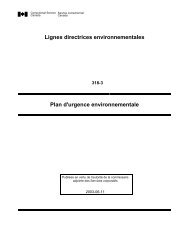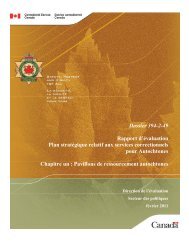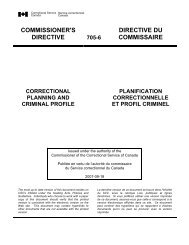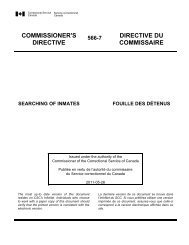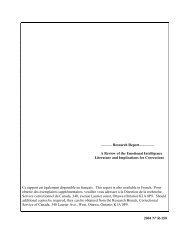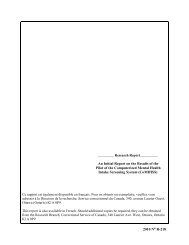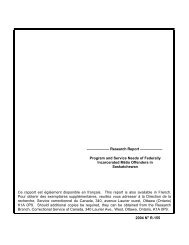Management of Halocarbons - Service correctionnel du Canada
Management of Halocarbons - Service correctionnel du Canada
Management of Halocarbons - Service correctionnel du Canada
Create successful ePaper yourself
Turn your PDF publications into a flip-book with our unique Google optimized e-Paper software.
Correctional <strong>Service</strong><br />
<strong>Canada</strong><br />
<strong>Service</strong> <strong>correctionnel</strong><br />
<strong>Canada</strong> EG 318-4 – <strong>Management</strong> <strong>of</strong> <strong>Halocarbons</strong><br />
SECTION 4 – DATA MANAGEMENT AND REPORTING<br />
RECORDS<br />
1. Whenever a refrigeration or air-conditioning system is decommissioned, a written record containing<br />
the information set out in Sche<strong>du</strong>le 5 (Dismantling, Decommissioning or Destruction Notice for a<br />
System) shall be kept on site in the service log.<br />
2. Whenever a refrigeration or air-conditioning system is installed, serviced, leak tested, repaired or<br />
charged, a written record containing the information set out in Sche<strong>du</strong>le 6 (Refrigeration System<br />
and Air-conditioning System <strong>Service</strong> Log) shall be kept on site.<br />
3. The institutional phase-out plan, i.e. the gra<strong>du</strong>al replacement sche<strong>du</strong>le, for refrigeration and airconditioning<br />
systems containing a halocarbon listed in any <strong>of</strong> items 1 to 9 <strong>of</strong> Sche<strong>du</strong>le 1 shall be<br />
kept on site and available at all time for review by RHQ and/or NHQ staff.<br />
4. All the documents required in these Environmental Guidelines (in particular, records, service logs,<br />
reports, notices or other relevant documents) shall be kept on site in the form <strong>of</strong> a central register <strong>of</strong><br />
halocarbons or integrated to the Environmental Information System (EIS), for a period <strong>of</strong> at least<br />
10 years beginning on the date <strong>of</strong> their issuance [see section 2.11 – Refrigerant Code <strong>of</strong> Practice].<br />
RELEASE REPORTS<br />
5. In the event <strong>of</strong> an accidental release <strong>of</strong> 100 kg or more <strong>of</strong> any halocarbon, the following reports shall<br />
be submitted to:<br />
• the appropriate Regional Division <strong>of</strong> Environment <strong>Canada</strong> (in priority),<br />
• the Regional Environmental Officer (REO), and<br />
• the Environmental Programs Section at CSC-National Headquarters (CSC-NHQ),<br />
a) within 24 hours after the day on which the release is detected, a verbal or written report that<br />
indicates the type <strong>of</strong> halocarbon released and the type <strong>of</strong> system from which it was released;<br />
b) within 14 days after the day on which the release is detected, a written report that indicates the<br />
information set out in Sche<strong>du</strong>le 7 (Halocarbon Release Report).<br />
6. If more than 10 kg but less than 100 kg <strong>of</strong> a halocarbon is released, written reports that contain the<br />
information set out in Sche<strong>du</strong>le 7 (Halocarbon Release Report) shall be submitted twice a year<br />
(mid-July and mid-January) to the Regional Environmental Officer (REO). The REO will then<br />
forward these reports to the Environmental Programs Section at CSC-NHQ so that NHQ submits<br />
semi-annual corporate reports to the appropriate Regional Division <strong>of</strong> Environment <strong>Canada</strong>.<br />
Environmental Programs, NHQ Page 10 2005-05-04


